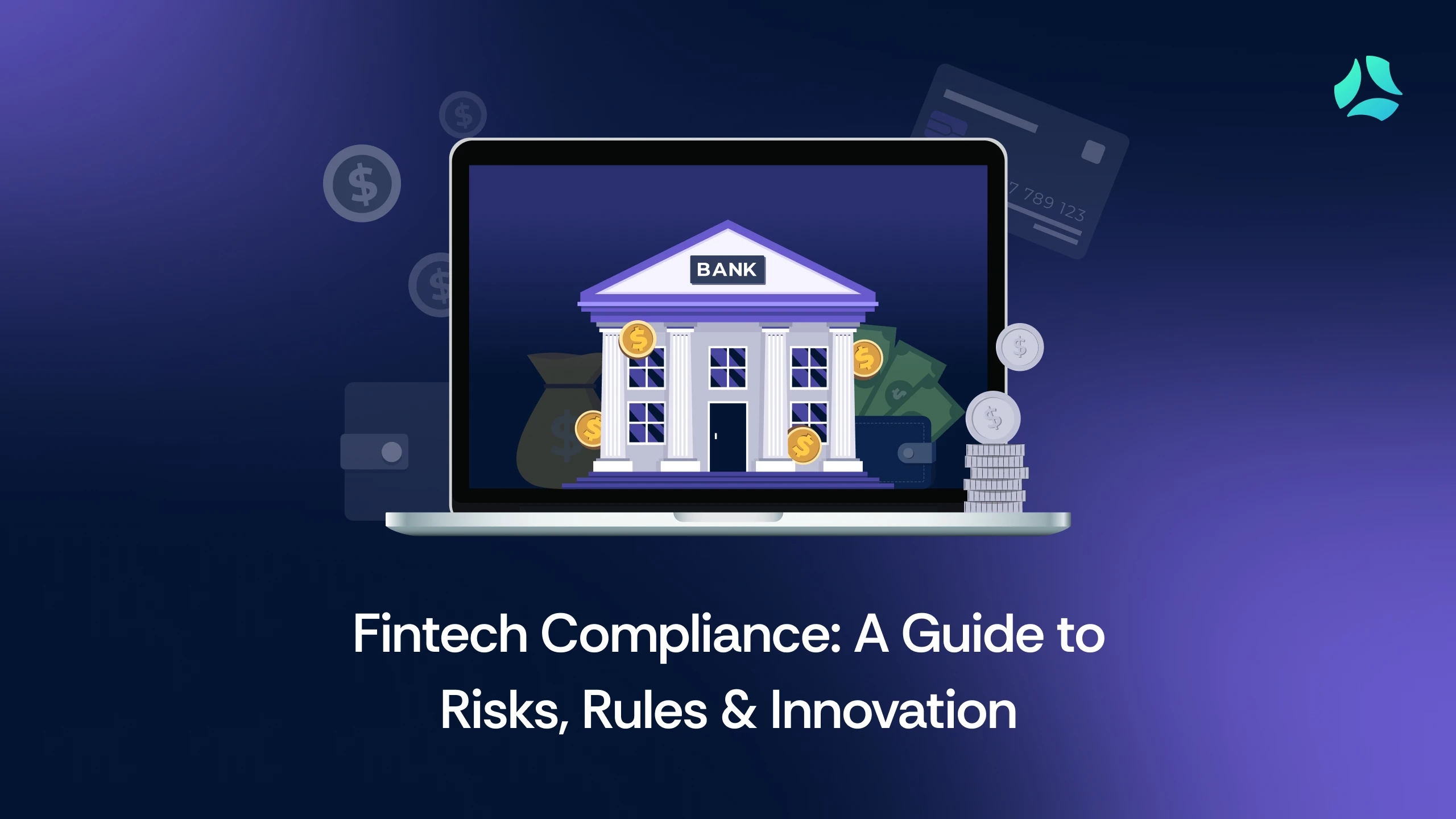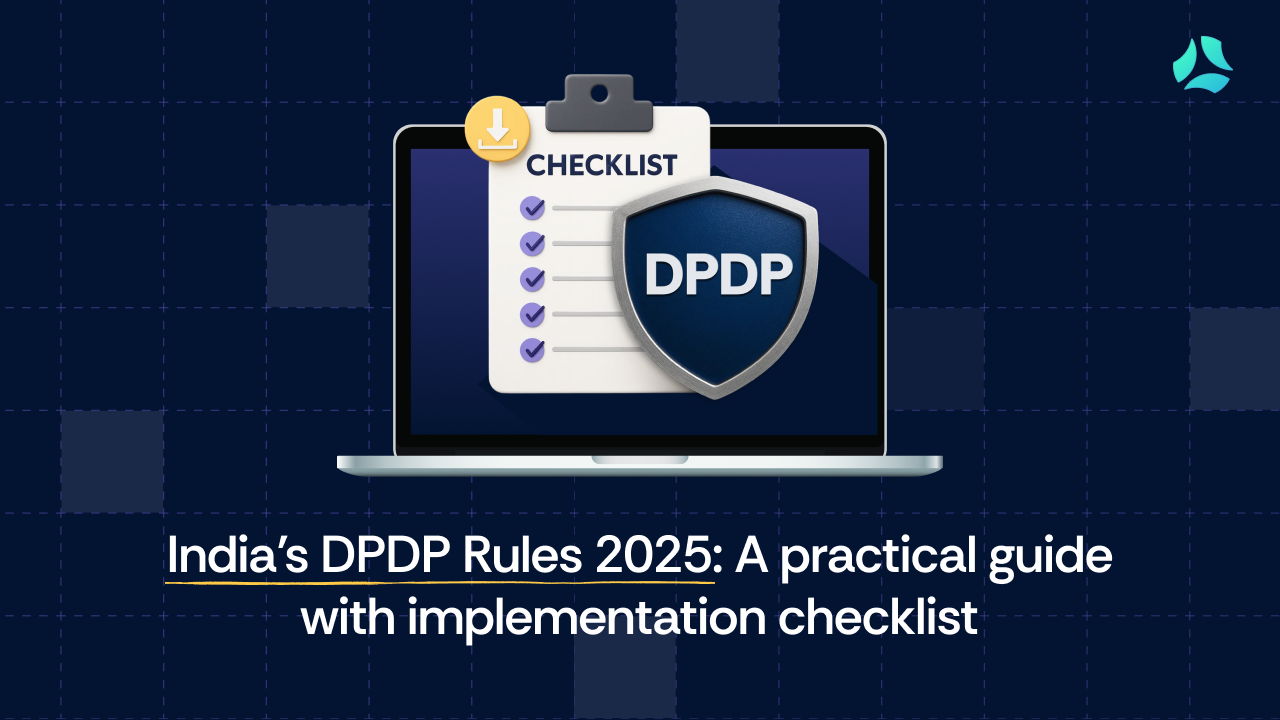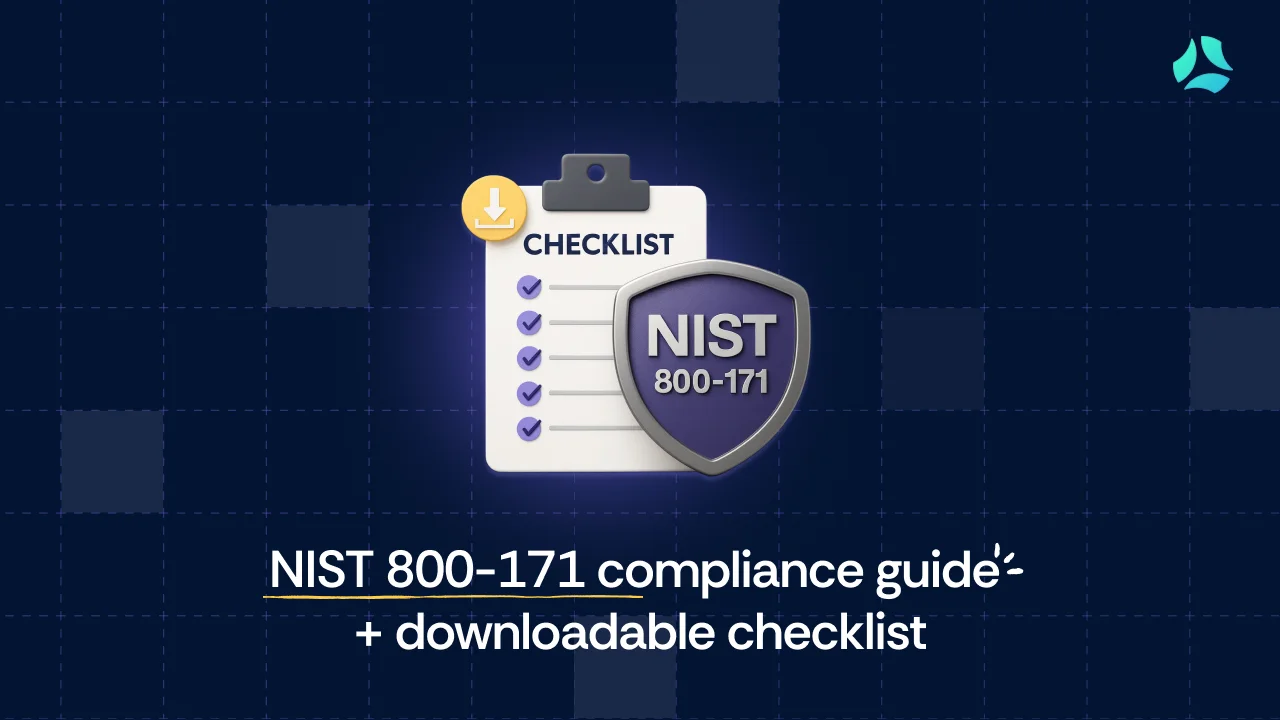Essential Guide to Fintech Compliance

Fintech compliance: A guide to risks, rules & innovation
Since the advent of digital wallets and payments, fintech companies have thrived under relatively lighter regulatory pressure. Thanks to this, these firms were always able to innovate faster than their banking counterparts.
However, their fast growth often outpaces existing regulations, leading to gaps in compliance frameworks.
Given that a significant amount of payment data and user information is at stake, they need a proactive compliance strategy. That means building robust controls for AML, sanctions, fraud detection, and data protection, backed by strong risk assessments, due diligence, and monitoring.
This article highlights the core compliance obligations fintechs must adhere to, so they can scale responsibly, mitigate risk, and continue delivering a secure, enhanced customer experience.
What is fintech compliance?
Fintech compliance refers to the rules, regulations, and security standards that fintech companies must follow to operate legally and ethically. It covers areas including cybersecurity, data protection, anti-money laundering (AML), KYC, and financial reporting. To stay compliant, fintechs either build in-house processes or rely on external solutions, like regtech tools and legal experts, to align their operations, products, and services with applicable laws and regulations.
For fintech companies, growth brings not only opportunity—but also complexity. Expanding product lines, entering new markets, and onboarding customers at scale all heighten the need for rigorous compliance. Fintech companies operating in different segments of financial markets need to give adequate attention to compliance to prevent inadvertent regulatory violations and penalties. For example, payment technology platforms must diligently follow know-your-customer (KYC) norms to prevent platform use for unlawful activities.
At its core, fintech compliance helps companies protect customers, prevent financial crimes, and avoid regulatory actions. But achieving and maintaining compliance isn’t just about ticking boxes—it’s about building scalable, resilient systems that can adapt to evolving regulations and business models.
Key components
A strong fintech compliance framework helps fintechs manage risk while enabling innovation.
The compliance framework includes multiple rules, regulations, and standards which can be grouped into four main categories: regulatory, operational, technological, and reporting.
Regulatory
Navigating fintech compliance across jurisdictions is one of fintech’s biggest challenges. Key requirements include:
- Know Your Customer (KYC) for customer identity verification to prevent impersonations and fraud. It helps financial institutions assess customer risk profiles and also ensure they are not inadvertently facilitating illegal money laundering activities.
- AML involves monitoring transactions to detect and report suspicious activity. It also includes customer due diligence, sanctions screening, and reporting of suspicious activities.
- Consumer protection includes transparency, fair lending, and clear dispute resolution processes.
- Fair lending practices are a core regulatory requirement in the United States, but its form varies across regions. It ensures that credit is offered and administered equitably, without discrimination, and with transparency and clarity on loan terms.
- Adherence to various financial regulations such as the Bank Secrecy Act and FATF standards, as well as data protection and security requirements like GDPR, PCI DSS, and more.
Technology
Fintechs often struggle to balance innovation with security. Strong tech infrastructure should include:
- Secure payment processing and electronic transaction controls.
- Information systems security, including encryption, firewalls, and patch management, to safeguard customer data and systems from breaches.
- IT governance and secure supply chain management.
- Vulnerability assessments and automated penetration testing to identify and fix system weaknesses.
Operational
As teams grow and processes become complex, keeping everyone aligned is crucial:
- Governance and risk management frameworks to align with regulatory expectations, including data privacy laws such as GDPR or CCPA.
- Continuous compliance monitoring and regular internal/external audits.
- Compliance training and awareness programs for employees.
- Regular risk assessments and real-time regulatory insights to respond to emerging threats.
- Vendor and third-party risk management, especially when compliance obligations extend beyond internal teams.
Reporting
Fintechs are often under pressure to deliver timely and accurate reports to regulators. This includes:
- Submitting correct and timely information to oversight bodies.
- Maintaining clear records of compliance activities, audit results, and corrective measures.
A robust fintech compliance framework isn't just about avoiding trouble. It helps you build trust, enabling expansion and protecting both customers and the business as it scales in an increasingly complex regulatory environment.
Key areas of fintech compliance
Fintechs operate at the intersection of innovation and regulation. Organizations must understand applicable regulations and key areas of compliance to effectively manage risks and maintain the trust of their stakeholders.
AML and counter-terrorism financing (CTF)
AML and CTF regulations require fintech companies to implement robust systems for detecting and preventing illicit financial activities. Regulators require fintechs to implement these measures to counter financial crime.
Fintech companies must adopt advanced technologies across the AML value chain—from client risk rating (CRR) on onboarding to client screening, transaction monitoring, and filtering. AML involves verifying customer identities, monitoring transactions for suspicious activity, customer due diligence (CDD), enhanced due diligence (EDD), recordkeeping obligations, and reporting unusual transactions to the authorities. The stringency of AML regulations depends on the scope and operational jurisdiction of the fintech services.
CTF's objective is to disrupt the flow of funds to terrorist groups and individuals. It also involves preventive financial controls, sanctions compliance, and risk-based approaches to customer onboarding. It is closely linked to AML efforts. Effective AML and CTF compliance programs help fintechs comply with global regulations and contribute to maintaining the stability of the broader financial system.
Data privacy and cybersecurity
Data privacy and cybersecurity are integral to fintech compliance, ensuring that customer-sensitive data is securely collected, stored, and transmitted. Fintechs must adhere to data regulations, such as the European Union’s General Data Protection Regulation (GDPR), which mandates explicit user consent, customer access to their data, and prompt breach notification. For example, Swedish fintech Klarna was fined $733,000 in March 2024 for GDPR violations for not providing sufficient information to its users.
Companies must use encryption, multi-factor authentication, and continuous threat monitoring to protect customer data against breaches and avoid legal and reputational damage.
Consumer protection
Fintechs should provide transparent services to consumers, clearly disclosing terms and fees while avoiding tactics like hidden charges. They should ensure financial inclusion by catering to underserved populations and following fair policies to avoid misrepresenting and mis-selling products and services. It’s also critical to establish processes for addressing customer complaints and grievances promptly.
Payment services and electronic money
Payment services and electronic money are subject to strict regulatory oversight to ensure secure, transparent financial transactions. Fintechs offering payment services must comply with licensing requirements and specific payment services regulations, such as the EU’s Payment Services Directive (PSD2). The SEC charged BlockFi Lending LLC (BlockFi) $100 million in penalties for failing to register its retail crypto lending product. It was accused of violating the registration provisions of the Investment Company Act of 1940.
Fintech regulatory landscape
As fintechs revolutionize the financial industry driven by technological innovation, it must operate within the regulatory framework to avoid punitive actions and fines. Multiple authorities govern the complex regulatory landscape, and it varies across geographies.
United States
The fintech regulatory landscape in the United States involves multiple agencies monitoring and enforcing various financial regulations. Some key regulatory agencies and their areas of responsibility are as follows:
- Consumer Financial Protection Bureau (CFPB) protects consumers by supervising fintech lending and financial products, enforcing consumer protection laws, and regulating non-bank fintech entities.
- The Securities and Exchange Commission (SEC) ensures investor protection and market integrity by regulating fintech activities related to securities trading and digital assets, including cryptocurrencies and non-fungible tokens (NFTs).
- The Financial Crimes Enforcement Network (FinCEN) enforces AML and CTF regulations under the Bank Secrecy Act, critical for fintech companies handling digital payments and cryptocurrencies.
- The Federal Deposit Insurance Corporation (FDIC) insures deposits and supervises traditional banks. It indirectly regulates fintechs through oversight of bank-fintech partnerships and third-party risk management.
- Commodity Futures Trading Commission (CFTC) regulates derivatives markets and engages with fintech innovators through LabCFTC, its dedicated initiative for promoting responsible innovation in areas like crypto derivatives and emerging technologies.
Besides, each state has its own regulatory bodies overseeing money transmission, lending, mortgage services, and insurance-related fintech activities. States like New York maintain particularly stringent licensing requirements for example, through its BitLicense framework for virtual currency businesses.
United Kingdom
In the United Kingdom, the Bank of England (BoE) plays a central role in maintaining the country's financial stability and overseeing critical infrastructure like payment systems and central bank digital currency initiatives. However, most fintech regulation falls under the purview of other dedicated agencies.
Financial Conduct Authority (FCA): Focuses on consumer protection, market integrity, and competition. Most fintechs (especially startups or non-bank lenders) fall under FCA supervision unless they operate as deposit-taking institutions or insurers.
The other fintech regulators are the Payment Systems Regulator (PSR), which promotes competition and innovation in UK payment systems, and the Information Commissioner's Office (ICO), which enforces data protection laws (GDPR, Data Protection Act 2018) and privacy rights.
Europe
The European Central Bank (ECB) is the primary regulator of financial institutions within the Euro zone comprising 20 countries. It regulates fintechs that are classified as banks under the Single Supervisory Mechanism (SSM). Some other key EU regulators are as follows:
- The European Banking Authority (EBA) sets prudential standards and supervises banks and fintechs for financial stability and risk management.
- European Securities and Markets Authority (ESMA) regulates securities markets, investment services, and cryptoassets to ensure investor protection and market integrity.
- European Insurance and Occupational Pensions Authority (EIOPA) oversees fintech that intersects with insurtech or pensiontech domains.
Each EU member state also has national regulators that focus on region-specific priorities.
Asia Pacific
Each country within the Asia Pacific region has its regulatory authorities overseeing fintech activities:
- Australian regulators include the Australian Securities and Investments Commission (ASIC), Australian Prudential Regulation Authority (APRA), and Australian Transaction Reports and Analysis Centre (AUSTRAC).
- The Monetary Authority of Singapore (MAS) is the key regulatory authority in the island country. It regulates all financial institutions and fintechs, ensuring financial stability and consumer protection.
- Indian regulators include the Reserve Bank of India (RBI), Securities and Exchange Board of India (SEBI), and the Insurance Regulatory and Development Authority of India (IRDA). The Ministry of Electronics and Information Technology (MeitY), focuses primarily on digital lending and data governance.
- Japan Financial Services Agency (JFSA) monitors financial institutions and fintechs for compliance, stability, and anti-money laundering measures.
- The National Financial Regulatory Administration (NFRA) was established in 2023, replacing the China Banking and Insurance Regulatory Commission (CBIRC), and it supervises banks, insurers, and fintech companies.
Fintech companies, especially those offering payments or digital platforms, are also regulated by the People's Bank of China (PBoC) and Cyberspace Administration of China (CAC) for data security and AML purposes.
- The Financial Services Commission (FSC), South Korea, regulates the country’s financial sector.
Other key regulators in the Asia Pacific region include Bangko Sentral ng Pilipinas (BSP), Bank Negara Malaysia (BNM), and Securities Commission Malaysia (SC).
Strategies to build a resilient fintech compliance program
A robust fintech compliance program is critical for navigating evolving regulations, mitigating risks, and building customer trust. Fintechs can build compliance capabilities in-house and/or collaborate with external providers to ensure comprehensive adherence to national and global financial regulations.
Managing in-house compliance
An in-house compliance team enables fintechs to maintain full control and deep integration with business operations. This approach enables direct oversight, tailored policy creation, and agile responses to regulatory changes.
However, in-house compliance teams require significant investment in talent like lawyers, compliance experts, finance managers, and others. Besides, fintechs need to invest in technology and training to stay current with evolving laws and risks. Additionally, they need to implement and manage extensive fintech compliance program components such as risk assessment methodologies, independent testing plans, training content and resources, and more.
Partnering with third-party advisors
You can collaborate with external consultants or law firms to help draft policies, review processes, and assess your workflows to ensure compliance with applicable regulations. This flexible model supports rapid growth, manages risks, and ensures compliance. It is helpful for early-stage fintech companies and those entering new markets or product categories. However, compliance consultants are expensive, which can be prohibitive, depending on the fintech’s product offering and service scope.
Leveraging banking-as-a-service (BaaS) solutions
Banking-as-a-Service (BaaS) enables non-banking companies to offer financial services—such as bank accounts, digital wallets, payments, and lending—by integrating regulated banking infrastructure, which forms the backbone of embedded finance. As the regulatory bar to becoming a bank is high in most markets, technology companies and non-banking companies offering financial services cannot become licensed banks. They often rely on BaaS to deliver these financial services.
This model is suitable for fintechs needing banking partners to provide customers access to bank accounts, payments, and lending. BaaS platforms offer pre-built, regulated infrastructure that streamlines compliance. BaaS providers typically offer built-in tools and support for regulatory functions like KYC, AML, and transaction monitoring, but fintechs may still retain legal responsibility depending on the jurisdiction and partnership terms.
Evaluating BaaS providers for fintech compliance
You should evaluate BaaS providers to ensure they provide regulatory support that meets your requirements and helps minimize operational risk. Fintechs should assess providers based on the following key criteria:
- Regulatory licensing: Assess if the provider holds relevant banking and money transmission licenses or partners with licensed banks and complies with applicable federal and state regulations.
- KYC/AML capabilities: Evaluate their processes for identity verification, transaction monitoring, and suspicious activity reporting.
- Compliance competencies: Check the number of employees dedicated full-time to compliance and the team's cumulative fintech compliance experience.
- Data security and privacy: Ensure the provider follows robust data encryption, access controls, and complies with standards like GDPR and CCPA.
- Audit and reporting: Check for regular internal audits, third-party assessments, and transparent reporting mechanisms.
- Disaster recovery and business continuity: Assess preparedness for data loss, downtime, or security breaches.
- Scalability and flexibility: Ensure the platform supports your growth and can adapt to changing regulatory needs. Ask for case studies showing how they’ve modified their program to meet a fintech client’s evolving needs.
- Reputation and track record: Assess their ability to support multiple types of companies across industries and business models through case studies and client testimonials. Review any history of regulatory issues or penalties.
It’s essential to assess a BaaS provider’s ability to support business growth at scale, as compliance requirements evolve alongside operations. Choosing the right partner lays the foundation for compliant, scalable fintech operations.
Fintech compliance risks and best practices
As a fintech company, you need to understand key compliance risks and adopt best practices to navigate an increasingly complex regulatory landscape.
Continuous monitoring and risk management
Continuous monitoring and risk management help fintechs detect suspicious activities, anomalies, policy violations, or system vulnerabilities early. This reduces the risk of regulatory breaches. Automated tools help track transactions and user behavior, flagging high-risk actions in real-time. Risk management frameworks help identify and prioritize threats, enabling you to plan proactive risk mitigation strategies.
Scrut’s continuous monitoring and risk management ensures proactive compliance and helps avoid punitive actions and fines.
Investment in compliance technology (regtech)
Compliance technology, or RegTech, enables fintech companies to automate and streamline complex regulatory processes. These tools enhance accuracy in KYC, AML, transaction monitoring, and reporting, reducing manual efforts and human errors. RegTech also helps fintech companies adapt quickly to evolving regulations.
Real-time analytics and dashboards provide valuable insights, supporting fast decision-making. It also allows fintechs to scale compliance efforts efficiently, even with limited personnel.
Future trends in fintech compliance
As fintech innovation accelerates, technologies like machine learning (ML), and artificial intelligence (AI), and evolving regulations are reshaping the compliance function.
Continuous risk assessment and real-time compliance
Ongoing risk assessments and real-time compliance monitoring have become the norm, driven by 24/7 transactions and a dynamic regulatory landscape. Automated alerts help fintech companies quickly address emerging risks and avoid compliance failure.
AI and machine learning for fraud prevention
Anomaly detection using AI and ML techniques helps with fraud detection and risk management in the financial services industry. Fintechs are using deep learning models to monitor every transaction in real time and generate fraud detection decisions in milliseconds. AI enables the integration and analysis of structured and unstructured data from multiple sources to enhance risk monitoring and detection accuracy.
Compliance by design and automation
Fintechs are increasingly embedding compliance controls directly into their systems using automation and AI. This “compliance by design” approach enables real-time monitoring, early detection of regulatory breaches, and seamless adaptation to new rules, transforming compliance from a reactive obligation into a strategic advantage.
These trends reflect a shift toward technology-driven fintech compliance frameworks that support innovation and ensure regulatory integrity.
Conclusion
One of the biggest challenges in financial services is meeting ever-evolving regulatory requirements. Fast-moving fintechs risk falling behind if compliance isn't prioritized. Even as fintechs strengthen controls, the growing volume of digital transactions can strain compliance resources and hinder risk management.
Fintech compliance is not a back-office function—it’s a strategic enabler of trust, growth, and innovation. As technologies evolve and digital activity expands, fintechs must invest in advanced infrastructure to ensure scalable customer due diligence, transaction monitoring, and screening programs are in place.
Scrut’s compliance automation platform enables you to manage regulatory requirements, mitigate risks, and stay agile in an ever-evolving financial regulatory landscape. It offers real-time insights into your compliance posture and ensures continuous monitoring across multiple frameworks and departments. It helps you ensure trust, security, and future-proof your fintech operations. Schedule a demo to learn more.
FAQs
1. What are the 5 D's of fintech?
The 5 D's of fintech are Democratization, Disruption, Digitization, Disintermediation, and Data. They reflect fintech's transformative impact on the financial and business landscape.
Fintech democratizes financial access by disrupting traditional models. They digitize financial services, making it easier for users to transact. They leverage advanced technologies to disintermediate by removing middlemen. They use data to personalize and optimize offerings, enhancing customer experience. Together, these forces redefine how financial services are delivered and consumed.
2. What are the three types of compliance?
Even though there are multiple types of compliance, they can be classified into three main categories.
- Regulatory compliance refers to adhering to government laws, rules, and regulations (e.g., GDPR, AML, SEC rules).
- Industry compliance refers to adhering to specific industry standards and regulations unique to a particular sector, such as finance, healthcare, or manufacturing.
Internal compliance refers to adherence to a company's internal policies and procedures to ensure ethical behavior and alignment with its values and business objectives. It also encompasses third-party compliance—ensuring that vendors, partners, and service providers meet the company’s standards for conducting business.


















